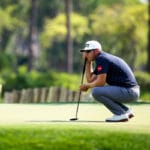Writing this in the immediate aftermath of the second ‘Major’ of the season, the US PGA Championship, staged at Oak Hill in New York State and won by LIV Golf rebel Brooks Koepka, younger readers of Irish Golfer magazine may be surprised to learn that this venerable championship was, once upon a time, played under match play conditions.
From its inception in 1916 and for two-score years with the exception of two short interruptions brought about by the two world wars, the Wannamaker Trophy was won under match play rules when, in 1927, another, more enduring iteration of golf mano-a-mano was born. The Ryder Cup was a transatlantic contest built around and famed for the unpredictable see-saw drama that match play golf alone can generate, a format where taking a triple bogey twice in a round need be no impediment to ultimate victory, unlike in stroke play when such wayward golf is likely to be punitive, if not terminal.
Meanwhile, half-a-dozen years after the USPGA switched formats from match to stroke play in 1958, Mark H McCormack, a young and ambitious lawyer from Columbus, Ohio, USA was urgently seeking a platform for the new recruits to his fledgling International Management Group (IMG), ‘The Big 3,’ of Arnold Palmer, Gary Player and Jack Nicklaus and a self-styled World Match Play Championship, to be played over Wentworth’s infamous West Course was McCormack’s vehicle of choice, and hugely significant and successful it was.
Few golf fans of a certain age will ever forget the ethereal autumnal experience that was Wentworth’s, ‘Burma Road,’ in the fall, misty mornings, up to 36-holes of daily match play golf played before huge, sold-out galleries and against a spectacular backdrop of mature trees displaying stunning hues of reds, oranges, and yellows, and the golf wasn’t half bad either; McCormack’s ‘Holy Trinity,’ sharing seven of the first eight titles before icons of the game including Greg Norman, Nick Faldo and Seve Ballesteros, who won five times in total, dominated what had become an iconic postscript to the European Tour season.
Wentworth resident Ernie Els then went on to dominate what was still the world’s foremost match play tournament in the years either side of the new Millennium, but by the time of the IMG chief’s untimely death in the spring of 2003, what was after all a self-appointed ‘World’ match play championship was beginning to lose some of its sheen, despite Tiger Woods having contested in 1998, losing in a dramatic final to his erstwhile friend and compatriot Mark O’Meara. Woods came back for his second and final appearance at the Wentworth showpiece in 2006, where, still at the peak of his powerful domination of the men’s professional game, and reigning world #1, Tiger summed-up the vagaries of match play golf.
“I have played some of my best golf [and] worst golf and won,” said Woods, explaining, “I think when you’re playing match play, anything can happen and that’s the difference between a 72-hole stroke play event versus a match play event.”
In losing to fellow-American Shaun Micheel, the 2003 USPGA Championship winner in the first round at Wentworth, encapsulated the capricious nature of what many consider to be the simplest and most authentic and alluring format in golf.
As time wore on, the Wentworth match play fell victim, not only of its own success, but also, despite offering a whopping €3m prize fund of which New Zealander Michael Campbell banked almost €1.5m – at that time, a world record for men’s professional golf – for defeating Dubliner Paul McGinley 2&1 in a dramatic 36-hole final, finding itself usurped by the PGA TOUR’s introduction of its own WGC Match Play.
HSBC pulled its sponsorship halfway through a 10-year deal after Ernie Els’ seventh and final victory in 2007, and, after a hiatus in 2008 and again in 2010, Volvo picked up what was increasingly seen as a busted flush, taking the flagging event – complete with a ‘Champion’s League’ round robin group phase inserted for padding – on the road to both Spain, Bulgaria and finally, in 2014, to its spiritual home of England. McCormack’s brainchild, although technically still alive and in cold storage on IMG’s books, followed its founder into oblivion one year short of its 50th golden jubilee, the end of a dewy-eyed halcyon era for match play golf.
Fast forward a few years and two seismic shocks, first the global financial crisis of 2008, then the COVID-19 pandemic of 2020 and 2021 and professional golf was forced into appraising every dollar spent, finding sponsorship ever-harder to leverage from big business reeling from the double whammy.
Minds became laser-focused, options considered and priorities chosen and match play golf, already the poor relation of the pro game, came under unprecedented scrutiny and the WGC Match Play looked increasingly vulnerable. Despite being granted ‘Elevated Event’ status in 2022 and 2023 and, regardless of attracting 18 of the top-20 on the OWGR this year, it looks certain that American Sam Burns, who defeated compatriot Cameron Young 6 & 5 in the final in Texas in March to win the US$3.5m first prize, may be the last man for quite some time – and arguably forever – to lift the distinctive pale-blue-and-gold Walter Hagen Trophy, the margin of victory and the early finish to proceeding it brought evidence of the unpredictability of scheduling match play golf and a proverbial dagger through the heart of the format.
In a comment heavy with irony, while Ernie Els was more than happy to hop over his back garden gate to tee it up – successfully and to his huge financial benefit, earning almost US$4million (Approx. €3.7m) from his seven victories – at Wentworth, the South African was less enthusiastic about crossing the Atlantic for the WGC version of the match play format, commenting, “You’ve got a 27-hour flight to maybe play one match,” and concluding, “It’s a long way to go for that.”
As recently confirmed by the WGC Match Play executive director Jordan Uppleger, the PGA TOUR / WGC version of the world match play championship seems set to follow its European Tour cousin into obscurity and an uncertain future is said to be a notable absentee from the 2024 PGA TOUR schedule, the WGC boss stating on the eve of the 24th and, most probably, final staging of mainstream golf’s last remaining mainstream regular match play tournament, “We’re formally announcing that the 2023 World Golf Championship Dell Technologies Match Play will be the final playing of the event here at Austin Country Club, and not be included on the 2024 calendar or moving forward.”
However, PGA TOUR chief Jay Monahan had hinted weeks earlier ahead of the Players Championship that reports of match play’s demise may be somewhat exaggerated, suggesting they could consider a match play event returning at some point, saying, “I think for right now, for next season’s schedule, it didn’t work,” adding, “But match play has been a staple out here, it’s been a staple on the DP World Tour [and] I think that will certainly be a consideration as we go forward.”
But Irish star Rory McIlroy, who took the WGC Match Play title in 2015 and, on finishing third in what could well be the 24th and final WGC Match Play tournament on the PGA TOUR made his views on the format’s place in the elite professional echelon of golf plain, saying, “It’s not on the schedule for 2024, but that’s not to say that it won’t be on the schedule for 2025.
“Match play is the purest form of the game and for the biggest tour in the world not to play a match play event would be a real shame.”
But Irish legend, the three-time ‘Major’ champion Pádraig Harrington holds a more nuanced view of match play golf, reflecting to Associated Press, “I used to love match play golf as a kid, as an amateur, it was my favourite [but] we play so much stroke play, it makes you cautious, you don’t want to make mistakes,” adding ominously, “Professional [stroke play] golf knocks the edge off you.”
Meanwhile, the DP World Tour, having lost the original McCormack-inspired version of the world match play championship almost a decade ago can boast just one match play event, the €2m Hero Cup, a low-key early season team based (GB & Ireland v Continental Europe match play tournament staged in the Gulf region aimed at galvanising European captains and preparing possible players ahead of the upcoming Ryder Cup in Italy.
Indeed, the only major professional tour paying more than a cursory nod to what Rory McIlroy insists is, “The purest form of golf,” is the LPGA Tour, which boasts three match play tournaments on its current schedule, although one, the Bank of Hope Match Play is, with a US$1.5m prize fund, the joint lowest of the 32 confirmed events whilst another, the Solheim Cup is biennial, the third, the Hanwha LIFEPLUS International Crown is a team-based format, leaving just one individual tournament played under match play conditions.
The women’s circuit mirrored the USPGA Championship’s pivot away from a match play format for the US$2m HSBC Women’s World Championship, a 64-player 18-hole match play event staged in the USA between 2005 and 2007, replacing it with the US$1.8m HSBC Women’s Champions, yet another stroke play event hosted in Singapore since 2008, further evidence that stroke play held sway over its match play cousin and with little or no sign of a reversal in that trend.
So, why then, given the huge sporting and commercial success of the Ryder Cup, the ‘Poster Boy’ of the match play format, and to a somewhat lesser extent, the women’s Solheim Cup and the PGA TOUR’s President’s Cup, has the format fallen out of fashion in the eyes of all the main pro circuits?
The received wisdom is that sponsors seek the predictability that 72-hole stroke play tournaments deliver, ditto broadcasters and tournament promoters / organisers and, it must be said, on-course galleries, as following match play can lead to whooping and hollering from distant part of the course, harbouring a sense of missing-out on the drama. Or could the alternative narrative be that the tours themselves, uber-conservative and cautious as they are, succumb to the ‘Devil you know’ mindset, when, surely another cliché, ‘Variety is the spice of life,’ is worthy of consideration?
So, here’s a thing; the four men’s and five women’s ‘Majors’ are all played under 72-hole stroke play rules, all are front-loaded on the calendar between April to August, and are, with the exception of the Open Championship, the AIG Women’s Open and the Amundi Evian Championship, exclusive to the USA, leaving a yawning void hanging over the entire southern hemisphere summer and all but two of the world’s continents, with Australasia, Africa, South America and the economic power-house that is Asia excluded and completely missing out.
And if, as they claim, golf’s custodians at the IGF, the R&A and the USGA and other powerbrokers such as the PGA TOUR, the PGA of America, the LPGA and the DP World Tour are as committed as they claim to be to strengthening and broadening the appeal of and participation in the royal and ancient game, what’s to stop them – other than pecuniary investment, media reach and a willingness to think less conservatively and more outside the box – creating an additional men’s and women’s ‘Major,’ bridging the seven-month annual calendar chasm and extending golf’s reach to south of the equator, and – echoing the pre-1958 USPGA Championship and exploiting the success of the Ryder and Solheim Cups, make the additional ‘Major,’ a global celebration of the match play format none other than Rory McIlroy considers to be, “The purest form of Golf.”























Leave a comment